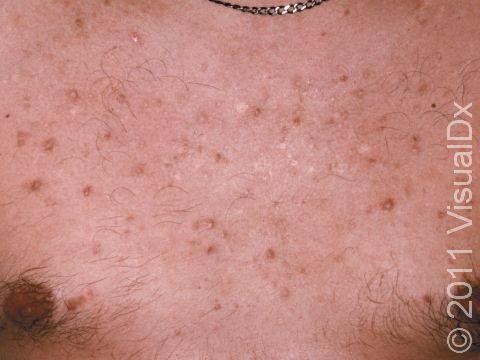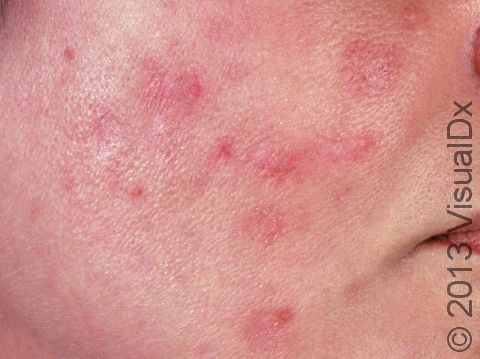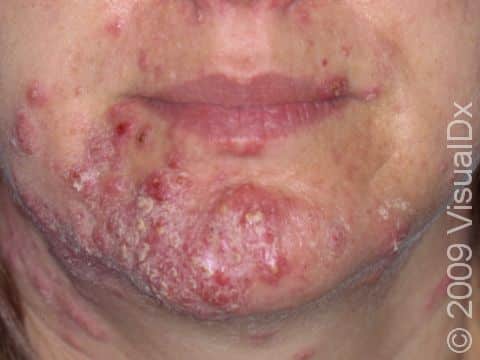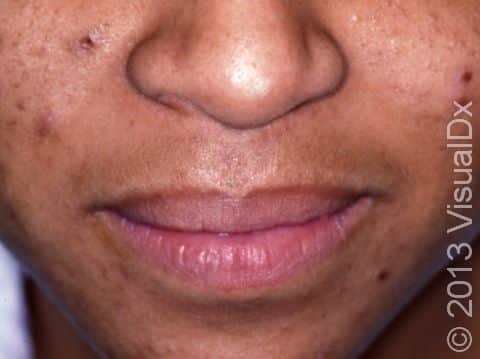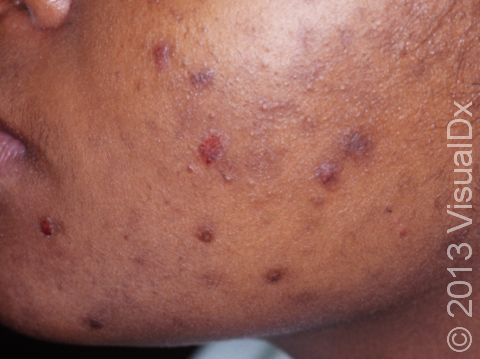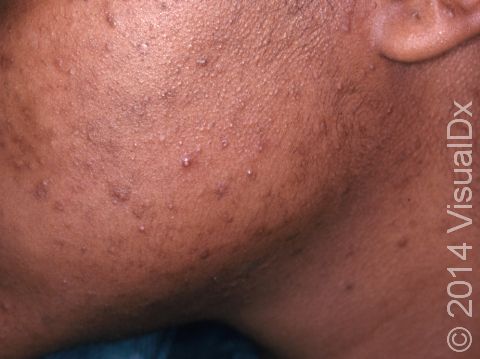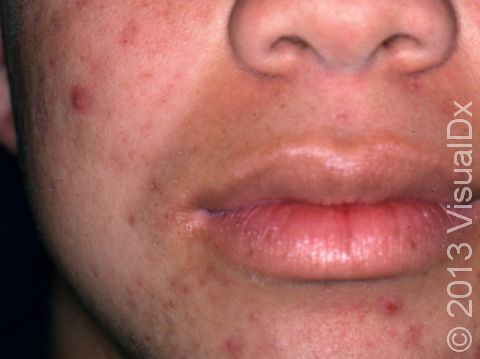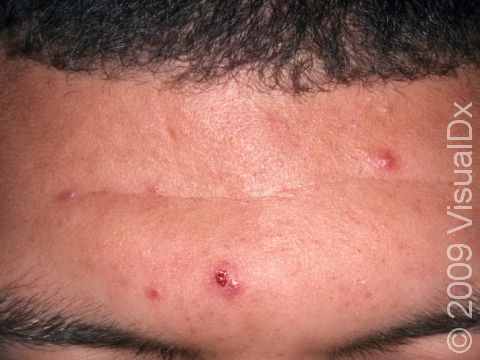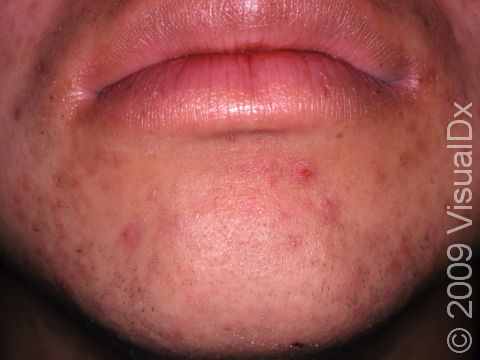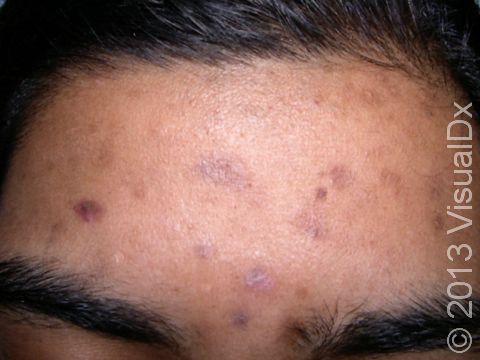Acne Excoriée
Acne excoriée, also known as “picker’s acne,” results when acne lesions are compulsively squeezed and scratched, resulting in scabs and scars. It is seen most commonly in adolescent girls and has been thought to be associated with underlying depression, anxiety, or emotional problems.
Acne, also known as acne vulgaris, is thought to be caused by multiple factors. Overproduction of a normal oil on the skin, called sebum, increases under the influence of hormones. This, coupled with insufficient shedding of exfoliating dead skin cells, plugs hair follicles. The plugged follicle can become inflamed and have increased growth of normal skin bacteria, Propionibacterium acnes. Medications such as lithium, cortisone, hormones, iodides, some seizure medications, or isoniazid can also cause acne lesions.
Acne can result in permanent scarring, so minimizing breakouts is important.
Who's At Risk?
Acne excoriée is usually seen in teen girls. Acne affects 85–100% of people at some point in their lives and usually begins at puberty.
Signs & Symptoms
Acne results in a variety of lesions. The most common acne locations include the face, neck, chest, and back, where the most sebaceous glands are located. “Blackheads” (open comedones) and “whiteheads” (closed comedones) are follicular plugs that are either oxidized from being exposed to the air (blackhead) or sitting below the skin surface (whitehead). Papules are small pink to reddish-brown bumps; pustules are superficial pus-filled lesions, and nodules or cysts are deeper pus-filled lesions.
Mild acne consists of a few papules/pustules and/or comedones. Moderate acne has an increased number of lesions. Severe acne has numerous comedones, papules, and pustules and may have painful nodules.
Picking can result in scabs, shallow sores, and permanent scars, which can either appear as depressions in the skin or hyperpigmentation, which is dark red or brown flat marks where the acne lesions were. The habit of picking at the skin may persist long after the acne has improved.
Self-Care Guidelines
There is no cure for acne. Acne can result in scarring, so minimizing breakouts is important.
Traditional treatments can help. Cleanse the acne-prone areas with gentle soaps or cleansers, and avoid irritants, such as rubbing and other alcohols, and abrasive scrubs and greasy products on the skin and in the scalp. Products labeled “water-based” or “noncomedogenic” will help reduce clogged pores.
There are also a variety of over-the-counter medications that may help. These are meant to be preventative therapies and should be applied in a thin layer to the entire area on a regular basis. If applied consistently you may see small improvements quickly, but results are generally seen after a few months. Benzoyl peroxide (most effective), is available in a variety of forms and strengths. Benzoyl peroxides tend to dry the skin, though, so if you have dry skin, use a weaker-concentration product; for oily skin, consider higher strengths. It can also bleach your clothing and towels. Peeling agents (exfoliants) such as salicylic acid, sulfur, resorcinol, and alpha-hydroxy acids (glycolic, lactic, pyruvic, and citric acid) can also help but will cause some dryness of the skin as well.
In acne excoriée, the habit of picking at the skin must be stopped. This habit may still persist after the acne has improved and may require behavioral therapy or counseling.
Treatments
Topical (or external) treatments include one or more creams, washes, or gels that include:
- Antibiotics such as benzoyl peroxide, clindamycin, erythromycin, sulfur, sodium sulfacetamide, and azelaic acid.
- Retinoids – vitamin A-derived products such as tretinoin, tazarotene, and adapalene.
Oral treatments may include:
- Antibiotics such as tetracycline, minocycline, doxycycline, erythromycin, ampicillin, clindamycin, trimethoprim-sulfamethoxazole, azithromycin, or cephalosporins.
- Oral contraceptives and spironolactone have been found to help regulate hormones.
- Isotretinoin, a strong drug with many side effects, for severe acne unresponsive to the above treatments.
Procedures:
- Special “blue light” treatments are a new way being investigated to treat acne but are usually not covered by insurance.
- Several types of laser treatments also help acne and are often used with other treatment methods; treatments are expensive, must be repeated for several months, and have variable efficacy. Insurance may not cover laser therapy.
- Laser resurfacing, plastic surgery, and/or dermabrasion may help reduce the prominence of old acne scars.
If there is evidence of excessive anxiety or depression, counseling may be suggested. Sometimes, anti-anxiety or anti-depressant medication may be prescribed.
Visit Urgency
Seek professional care if you have moderate or severe acne that has not improved enough with self-care. Speak with your doctor if you have any feelings of depression or anxiety.
References
Bolognia, Jean L., ed. Dermatology, pp. 116. New York: Mosby, 2003.
Freedberg, Irwin M., ed. Fitzpatrick’s Dermatology in General Medicine. 6th ed, pp. 684. New York: McGraw-Hill, 2003.
Last modified on October 5th, 2022 at 6:57 pm

Not sure what to look for?
Try our new Rash and Skin Condition Finder
